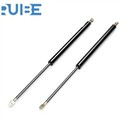Gas spring is an industrial accessory that can function as support, buffer, braking, height adjustment and angle adjustment. It consists of the following parts: pressure cylinder, piston rod, piston, sealing guide sleeve, filler (inert gas or oil-air mixture), in-cylinder control elements and out-of-cylinder control elements (referring to controllable gas springs) and joints. The principle is to fill the closed pressure cylinder with inert gas or oil and gas mixture, so that the pressure in the cavity is several times or tens of times higher than the atmospheric pressure, and the pressure difference generated by the use of the cross-sectional area of the piston rod is smaller than that of the piston. to achieve the movement of the piston rod. Due to the fundamental difference in principle, gas springs have significant advantages over ordinary springs: relatively slow speed, little change in dynamic force (usually within 1:1.2), and easy control.
The disadvantage is that the relative volume is not as small as the coil spring, the cost is high, and the service life is relatively short. Unlike mechanical springs, gas springs have a nearly linear elastic curve. The elastic coefficient X of the standard gas spring is between 1.2 and 1.4, and other parameters can be flexibly defined according to requirements and working conditions.






